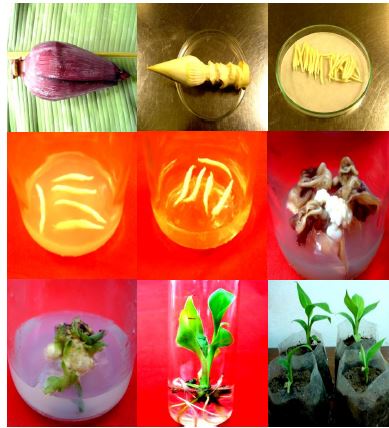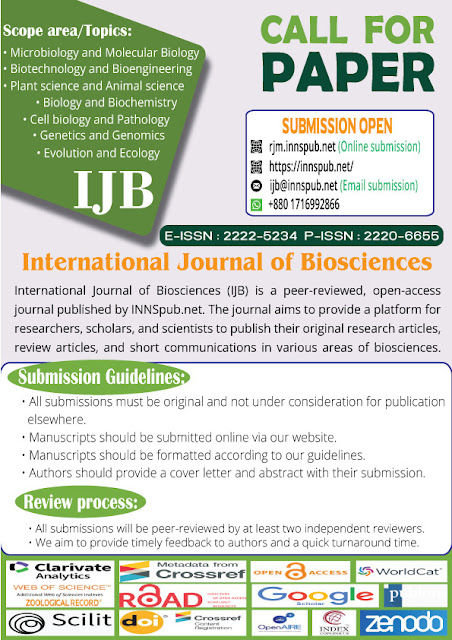Md Tipu Sultan, Mahboob
Hossain Khan, Md Lokman Hakim, ANK Mamun, Md Alam Morshed, Md
Rofiqul Islam, and Md Rokibul Islam, from the different institute
of the Bangladesh.. wrote a research article about, Banana Male Flower In
Vitro Regeneration. entitled, In vitro plant regeneration from male flowers of
banana. This research paper published by the International Journal of Biosciences (IJB). an open access scholarly research journal on
Biosciences. under the affiliation of the International Network
For Natural Sciences | NNSpub. an open access
multidisciplinary research journal publisher.
Abstract
The present study was
undertaken with a view to establish a protocol on in vitro regeneration of
plants by using young male flowers of banana (Musa sp. cv. Sabri) as explant.
Appropriate developmental stage of immature male flowers for inoculation,
medium composition for induction of calli, regeneration of plants, rooting of
in vitro regenerated shoots, acclimatization of in vitro regenerated plantlets
and ex vitro establishments of plantlets were worked out. Young male flowers
obtained by striping away the bracts in between 24 to 26 were found suitable as
explants for induction of callus. The isolated male flowers were cultured on MS
(Murashige and Skoog) medium supplemented with different concentrations and
combinations of three auxins viz. 2, 4-D (2,4-Dichlorophenoxyacetic acid), NAA
(Napthaleneacetic acid) and IAA (Indole-3-acetic acid) for induction of callus.
Only two of the two medium composition yielded calli. The better response (20%)
was recorded in MS medium containing 2.0 2, 4-D + 0.5 NAA + 0.5 IAA
(Indole-3-acetic acid) (mg/l). The calli were cultured on MS medium fortified
with different concentrations of BA (Benzyladenine), NAA, IAA and Glutamine or
Caesin hydrolysate (CH) to regenerate shoots. MS medium having the
supplementation of 1.0 BA + 0.5 IAA + 500 CH (mg/l) was appeared best for
regeneration of shoots. Single isolated regenerated shoots were implanted on MS
medium supplemented with three different concentrations (0.5, 1.0 and 2.0 mg/l)
of IBA or NAA to induce root. IBA at a concentration of 1.0 mg/l produced best
rooting. The plantlets were gradually acclimatized and transferred to the soil.
The survival percentage was about 90%.
Read more : Stocking Density Impact on Tilapia Juvenile Growth and Survival | InformativeBD
Introduction
Banana is one of the
most important and remunerative cash crops grown round the year in Bangladesh.
The energy and nutritional status of banana are much higher than other common
tropical and subtropical fruits. The average yield of banana is 14 t/ha, which
is lower compared to other banana-producing countries in the world (Islam and
Hoque, 2004). Higher yield of banana can play a pivotal role in the economy of
Bangladesh. It is possible to increase the yield of banana by using disease
free high yielding variety, modern technology of production as well as post
harvest management. Banana (Musa spp.) is one of the most important nutritious
fruit crops of the world and grown in many tropical areas where they are used
both as a staple food and dietary supplements (Assani et al., 2001).
In our country, Sabri (AAB) is the second important commercial cultivar of banana after Amritsagar (AAA) (Islam and Hoque 2004). However, cultivar Sabri is highly susceptible to panama disease (Fusarium wilt) caused by Fusarium oxysporum ssp. cubense. So, there is a scope to improve this variety by the development of somaclonal variant through indirect oraganogenesis. Most of the edible bananas are sterile polyploids and must be propagated vegetatively. So, genetic improvement of this plant through cross breeding is an insurmountable task. Tissue culture technique using shoot or meristem tips are suitable for large-scale production of uniform and vigorously growing propagules for field establishment. The combination of mutation breeding and in vitro culture has been suggested as an alternative approach for banana improvement (Novak et al., 1990). However, the main limitation of this technique is the high degree of chimerism. Repeated vegetative propagation is needed to dissociate chimeras, but the minimum requiring number of cycles is unknown (Roux, 2004). So, somaclonal variation may be an alternative option for the improvement of banana ( A.H. Kabir et al., 2008; Nasrin,S. et al., 2003; Denise M. Seliskar et al., 2000; Larkin, P.J. et al., 1981;). Keeping the above significant points in mind, the present research aimed at regenerating plants through indirect organogenesis in banana by using young male flower buds as explants. The specific objectives of the present study are (i) to find out suitable stage of development of male flower bud as explant, (ii) to optimize growth regulators in culture medium for induction of calli and for shoot regeneration from calli, (iii) to optimize auxins in the culture medium for induction of root in regenerated shoot, and (iv) to acclimatize, harden and establishment of the plantlets in the soil.
Reference
Kabir AH, Mahfuz I,
Razvy MA, M. MB, Alam MF. 2008. Indirect Organogenesis and Somaclonal
Variation in Four Rice Cultivars of Bangladesh. Journal of Applied Sciences
Research 4(4), 451-458.
Alsadon AA, Al-Mohaideb
M, Rahman MH, Islam R. 2004. Evaluation of vegetative growth traits of
eight potato cultivars. Bangladesh J. Genet. Biotech. 5(1&2), 61-64.
Assani A, Bakry F.,
Kerbellec F. 2001. Plant regeneration from protoplasts of dessert banana
Grande Naine (Musa spp., Cavendish sub-group AAA) via somatic embryogenesis,
Plant Cell Rep. 20, 482.
Bakry F, Assani A,
Kerbellec F. 2008. Haploid Induction: androgenesis in Musa balbisiana.
Fruits 63, 45-49.
Bhaskar J, Arvindakchan
M, Balsalakumari PK, Rajeevan PK. 1993. Micropropagation studies in
banana. South Indian Hort. 41, 186-191.
Denise M. Seliskar,
John L. Gallagher. 2000. Exploiting wild population diversity and
somaclonal variation in the salt marsh grass Distichlis spicata (Poaceae) for
marsh creation and restoration; American Journal of Botany 87(1), 141–146.
Hakim L, Ahmed G, Kabir
H, Mamun ANK, Roy PK, Islam MR, Khan R. 2008. Production of doubled
haploids in banana. Abstract. Proc. FAO/IAEA Intl. Symp. Induced Mutations in
Plants held in Vienna, Austria from 12-15 Aug., 2008. IAEA-CN-167-263P, 121.
Hong W, Debergh P.
1995. Somatic embryogenesis and plant regeneration in garden leek. Plant
Cell Tissue and Organ Culture 43, 21-28.
Islam S, Hoque A. 2004. Status
of banana production in Bangladesh. Molina, A.B., Eusebio, J.E., V.N. Roa, I.
Van Den Bergh, M.A.G. Maghuyop, K.H. Borromeo (eds.). Advancing banana and
plantain R&D in Asia and the Pacific, Proc. 2nd BAPNET Steering
Committee Meeting, Jakarta, Indonesia 12, 33-41.
Kaeppler SM, Kaeppler
H.F, Rhee Y. 2000. Epigenetics aspect of somaclonal variation in plants.
Plant Mol. Biol. 43, 179-188.
Khanam D, Hoque MA,
Khan M.A., Quasem A. 1996. In vitro propagation of banana (Musa sp.). Plant
Tissue Culture 6, 89-94.
Kulkarni VM, Suprasanna
P, Bapat VA. 2006. Plant regeneration through multiple shoot formation and
somatic embryogenesis in a commercially important and endangered Indian banana
cv. Rajeli. Curr. Sci. 90(6), 842-850.
Larkin PJ, Scowcroft
WR. 1981. Somaclonal variation and crop improvement. In:Genetic
Engineering of Plants. An Agricultural Perspective, T. Kosuge, C.R. Meredilh
and M. Hollander (eds.) Plenum Press, 289-314.
Nasrin S, Hossain MM,
Khatun A, Alam MF, Mondal MRK. 2003. Induction and evaluation of
somaclonal variation in potato (Solanum tuberosum L.). Bio. Sci. 3(2), 183-190.
Novak FJ, Afza R, Duren
MV, Omar MS. 1990. Mutation Induction by gamma irradiation of in vitro
cultured shoot-tips of banana and plantain (Musa sp.), Trop. Agr. (Trinidad) 67, 21-28.
Raut RS, Lakhnade VE.
1989. Propagation of plantain through meristem culture. Ann. Plant.
Physiology 3, 256-260.
Roux N. 2004. Mutation
induction in Musa – review. In: Banana Improvement –Cellular, Molecular Biology
and Induced Mutations (Mohan J. and S. R. Swennen, Eds.), Science Publishers,
Inc., Enfield (NH), USA, Plymouth, UK, 23-32.











%20in%20full.JPG)


0 comments:
Post a Comment